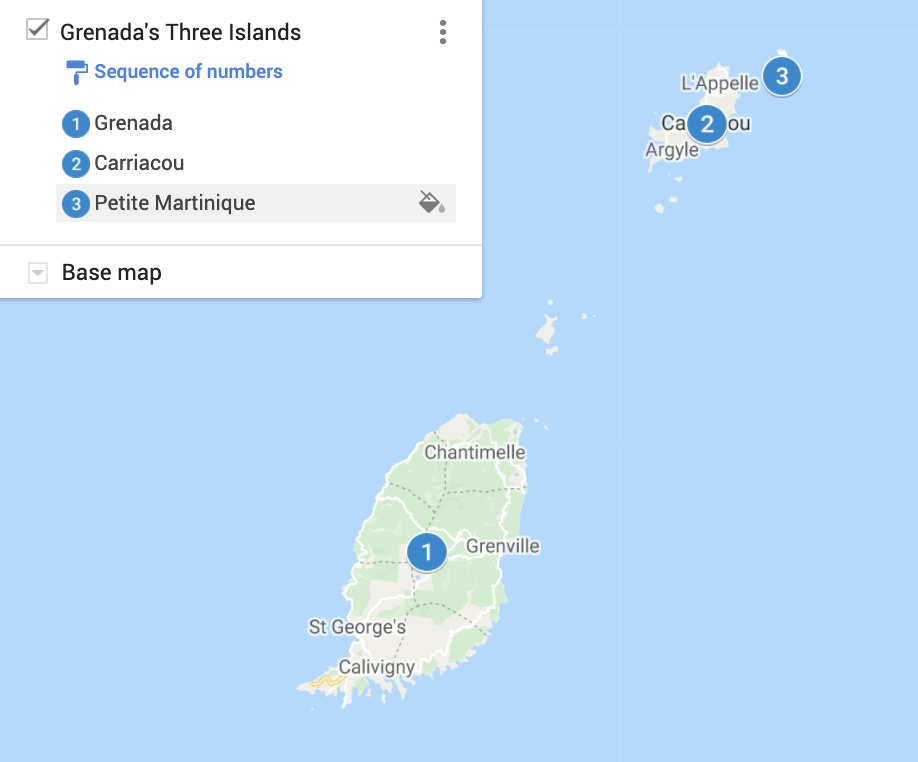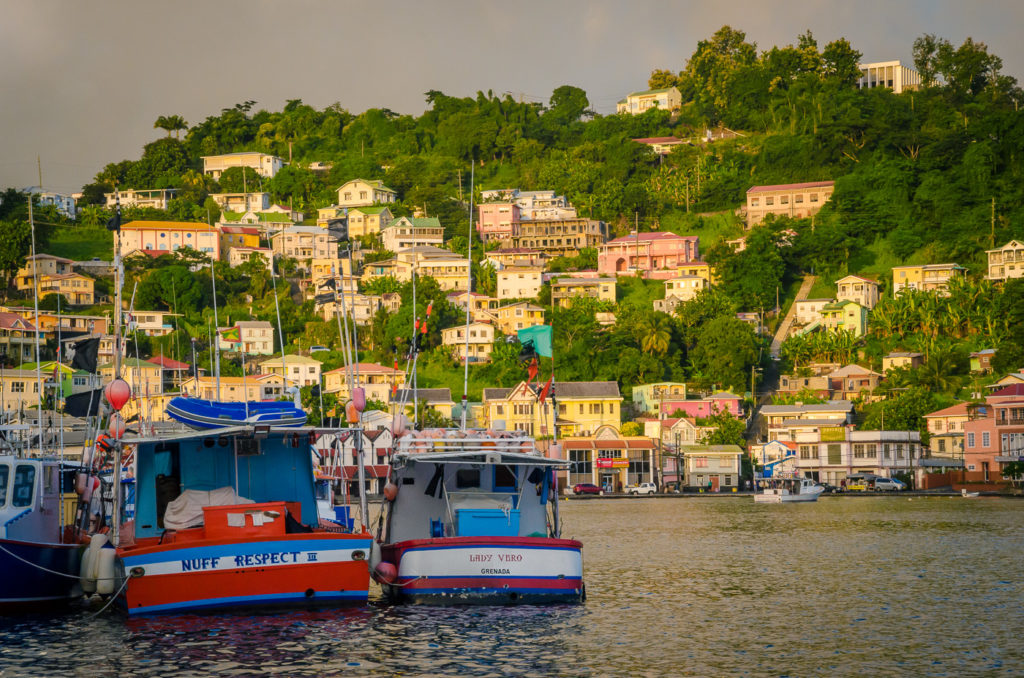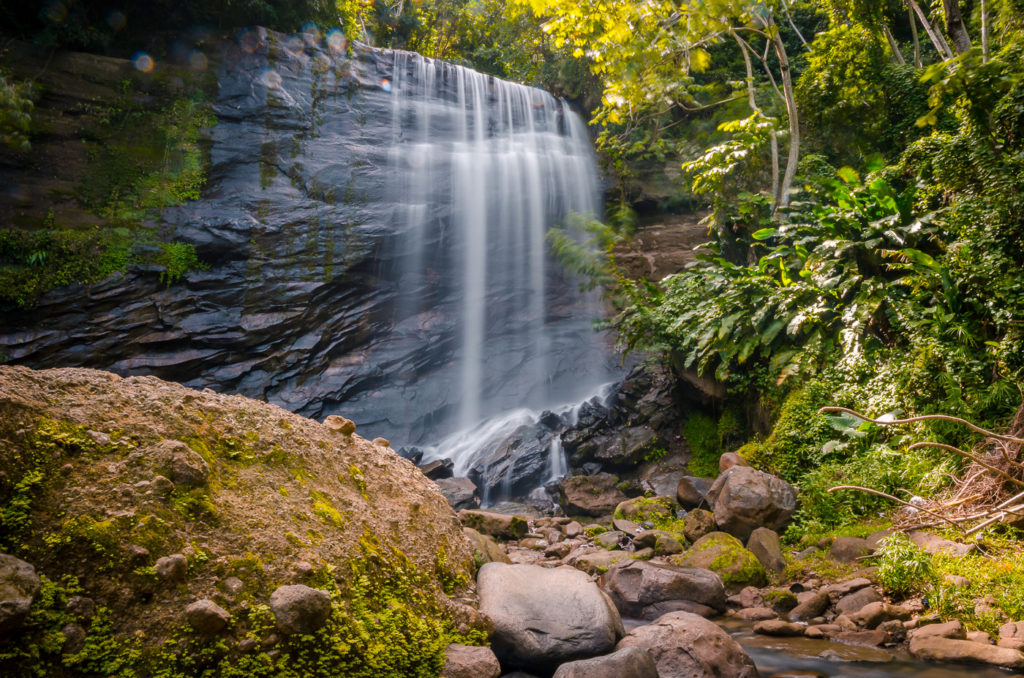I’ve wanted to travel to Grenada since America invaded this tiny country in 1983. So, we decided to visit and see for ourselves how this came about. While it had tangential Cold War significance, it seems amazing today that anyone would want to fight there. Rather, it’s a place with a lovely capital and an alluring harbor, St George’s.

It’s known as the “Spice Island” and provides about a quarter of the world’s nutmeg, but we focused on learning about its cocoa production, from raw plants to chocolate bars.

Of course, this is the Caribbean and Grenada has its share of lovely beaches…

displays of colors…

and friendly people, such as this lady selling fruits on the side of the road.

Where’s Grenada and How To Get There?
Grenada is an island country in the Lesser Antilles, an arc of volcanic islands. It’s the most southern island of the Windward Islands extending north to Dominica. The Windward Islands are called this because the winds mostly propelled ships from Europe to Africa. The islands north of Dominica are the Leeward Islands (the winds are mostly against ships sailing from Europe and Africa) extending from Guadeloupe to the Virgin Islands.

There are several flights from the U.S., Canada, and the U.K., flying nonstop to Maurice Bishop International Airport (code: GND). The airport is just a twenty-minute drive to St. George’s, the capital city. LIAT and Caribbean Airlines provide flights into Grenada from many Caribbean islands, some with connections to international flights.
How to Travel in Grenada
My wife Khadija and I spent a week in Grenada in November 2018. It’s a small place, only 135 sq mi (350 sq km), a little bigger than New York City. It has three main islands, Grenada, Carriacou, and Petite Martinique. The last two border the southern islands of Saint Vincent and the Grenadines. We spent a half-day touring Carriacou, taking a two-hour ferry ride each way from St Geoge’s, sometimes over rough water.

We traveled throughout the mountainous Island of Grenada and visited the places indicated on this map.

It takes less than two hours to drive from the southern tip to the northern end. We rented a car one day from our hotel and went around the perimeter. We drove on a Sunday, which we would not do again, as almost everything was closed. On another day, we hired a car and driver from Sunsation to explore the interior. Besides those excursions, we stuck to the St George’s and Grand Anse Beach areas and primarily used minivans which were plentiful, cheap, and often had good music.
Taxis are an option, but we found them 10X or more expensive than minibusses and not that much faster.
Cars drive on the left-hand side of the road, so you need to be careful if you are not used to it. Most drivers adapt very quickly but need to be aware things on the driver’s side are closer than you may realize. Roads are generally two-lanes or occasionally one-lane shared by vehicles and pedestrians such as Sendall Tunnel in St George’s.

If you are lost, locals are helpful in giving directions. The population of Grenada is only a little over 100,000, so everywhere feels like a small town. While this is a teeny Caribbean island, there are many more Grenadians working abroad, primarily in the U.S., U.K., and Canada. As a result, they may know something about where you live. Literally, everyone we spoke to had a relative living in Brooklyn.
Where to Stay and Eat in Grenada
Because the main island is small, anywhere you stay is not far from anything. There’s no need to stay in more than one location. We stayed at the elaborately landscaped Blue Horizons Garden Resort between the airport and St. George’s, close to Grand Anse Beach. The rooms were in cottages on hills and had excellent views.

We ate mostly in small restaurants serving local fare of seafood and stews of various meats and root vegetables. The restaurant we really liked and went to three times was Caribe Sushi.

Having eaten tons of Japanese food in New York and Japan, I could tell their Japanese and Filipino chefs knew what they were doing.
Is Grenada Safe?
Grenada is definitely a safe place with few crimes against visitors. If you use normal precautions, such as not going down dark alleys at night by yourself with expensive cameras, you should be fine.
St George’s
Saint George’s is one of five world capitals with an apostrophe (others are N’Djamena of Chad, Nuku’alofa of Tonga, Sana’a of Yemen and Saint John’s of Antigua and Barbuda). Besides being part of that small club, it’s a hilly city around a mitten-shaped harbor with a long thumb, filled with private boats and cargo ships.

There are two places you should check out. First is Fort George located on a high but walkable hill next to the harbor, hosting old buildings and a row of cannons.

The multi-level complex was built in the early 1700s by the British, previously a cannon-battery for the French. Perhaps the best thing about the Fort is the scenic overview of St. George’s.

The second is the Grenada National Museum, located in a few small rooms in a two-floor, waterfront building.

The collection includes items from indigenous Arawak people and the colonial plantation-society. There is one room focusing on the four-year term of the Maurice Bishop administration. The most fun I had was strolling the streets and getting some serious exercise while trudging up the steep hills.

Just west of St George’s is Charlie’s, a roadside bar with the most amazing display of Caribbean pride.

The eponymous owner has painstakingly created a hillside feast for the eyes using old tires and gallons of Caribbean colors. While there, stop for a drink and chat with the gregarious Charlie.

Grand Anse Beach
Grand Anse is the most famous beach in the country (not to be confused with the beach of the same name in the Seychelles).

It lives up to the hype with a 2 mi (3.2 km) stretch of soft sand which locals and tourists frequent. There’s no charge, although some chairs belong to resorts next to the beach and are exclusively for their guests.
Belmont Estate
As Grenada is known for its spices, we stopped at this 400-acre (160 hectares) estate to supplement our limited agricultural knowledge. Belmont Estate has been in existence for over 400 years under various owners. Our tour guide explained the fermenting and drying process, which takes several days to turn cocoa beans into chocolate. At the end, we observed the final, indoor part of the process: mixing chocolate with sugar and other ingredients in an immaculate, industrial kitchen-like facility.

When you’re done, you can buy a variety of chocolate candies and powders!
Pearls Airport
If you remember, my main motivation for coming to Grenada was to understand why the U.S. felt so compelled to invade a speck in the Caribbean Ocean. All I vaguely recollected was that American medical students studying here were in danger. After visiting the Grenada National Museum and coming to the abandoned Pearls Airport with Cuban and Russian airplane relics, I put together the main outline of events.

Grenada gained independence from the U.K. in 1974. In 1979, Maurice Bishop led his Marxist-Leninist party in overthrowing the government and establishing an autocratic, socialist regime. To the Reagan White House, this was an ominous event, which could spread communism throughout the Caribbean and Central America.
The Bishop government started building a new airport close to St George’s, as the Pearls Airport was too small for larger planes and the surrounding mountains prevented expansion. The U.K., Cuba, and Libya helped in the construction. The U.S. was concerned that the new airport would accommodate large Soviet aircrafts carrying weapons and dismissed the idea as strategic economic development.
In late 1983, Deputy Prime Minister Bernard Coard seized power and placed Bishop under house arrest. Bishop soon escaped but unfortunately was caught and executed by a firing squad. The army then placed the country under military rule.
The U.S. decided to invade, based on a request from the Organization of Eastern Caribbean States (OECS) and ostensibly over concerns for the 600 U.S. medical students on the island. The result of the invasion was never in doubt because of the overwhelming superiority of American forces, as shown in this photo from Al Jazeera.

In a week, the U.S. took over the island after subduing about 1,500 Grenadian soldiers and about 700 armed Cubans. The UN General Assembly condemned the invasion in a lopsided vote.
When US troops withdrew from Grenada a couple of months later, the country was governed by an interim administration until elections in December 1984. In October 1984, the new Point Salines International Airport (renamed Maurice Bishop) was opened and the country could accommodate large commercial jets for the first time. The Pearls Airport was left in ruin and the airstrips are now used for drag-racing.

Royal Mount Carmel Waterfall
Grenada has a number of modestly sized waterfalls. We went to this one, a short walk off the side of the road. We paid a small admission fee (not sure it was required) to a man who accompanied us. I particularly liked the angle of this fall. I imagine during the rainy seasons it would be quite dramatic.

When driving through the country, we noticed many large homes being constructed.

We found out that Grenadians who worked abroad have come back here for retirement and are able to build mini-mansions from their savings.
Grand Etang National Park & Forest Reserve
Grenada is a great place for hiking trails of various difficulties. A good place to stretch your legs is in Grand Etang National Park & Forest Reserve. It’s known for the charming Grand Etang Lake, occupying a crater of an extinct volcano. The park has its share of wildlife including tropical birds, frogs, lizards, opossums, armadillos, and mongoose. The star is the Mona monkey.

Locals encourage visitors to take selfies with a monkey on their shoulders. While the pictures are fun to show the folks back home and on Instagram, this practice unnaturally acclimates the animal to humans. In addition, sometimes it’s dangerous for people as they are dealing with wild animals with claws and teeth which can cause damage.
Carriacou
For a change of pace, we spent a day traveling to and from Carriacou Island, which only has a population of about 10,000. It has lodging if you want to stay overnight. Next to it is Petite Martinique, which has about 1,000 residents and no hotels, but nice relaxing beaches. The ferry ride from St George’s takes from 90 minutes to 2.5 hours, depending on sea conditions. Our ride started smoothly and we were able to enjoy the coast of the Island of Grenada.
About two-thirds of the way, the water became very rough. All the passengers were sitting and hanging onto something. My stomach was churning but fortunately, I kept it under control. When we got to the ferry station, we met Randolph Joseph who offered to be our guide.

Randolph is an architect and general contractor, who gave us considerable information on the island’s buildings. Carriacou is most famous for its shipbuilding, which is curious as the island has few trees and no facilities to make tools. Generations ago, Scottish immigrants started the local industry and it’s one of the few places left in the Caribbean where boats are built on the beach using traditional tools and techniques.

While new boats are being built, you can still see shipwrecks offshore.

In 2004, Grenada was devastated by Hurricane Ivan, a category 3 storm. It destroyed much of the power distribution system and tourism infrastructure. It caused widespread damage to nutmeg crops, which take five to eight years to bear fruit. A vast majority of the buildings were damaged. Because Carriacou is flat and has few trees, it’s easier to see the remnants of the destruction.

On the island, there are scenic overlooks such as this one with a cannon from centuries ago.

Since the island is peaceful, it’s easy to meet local folks, such as this construction worker.

Other Attractions
There are a couple of worthwhile activities we couldn’t manage to fit into our schedule.
There are several mountains for non-technical climbing. The highest is Mount Saint Catherine (elevation 2760 ft / 840 m) which is usually quite muddy but has spectacular views. As the trails are not well marked, it is highly advisable to have a guide.
The Underwater Sculpture Park in Grenada’s Molinere Bay was designed in 2007 by British sculptor Jason deCaires Taylor, who later created similar installations around the world.
Final Thoughts
Grenada offers a good combination of activities, so you can easily keep occupied for a week. However, it’s also a good place to relax and soak up the natural beauty, as Khadija did in this picture.

Grenada is definitely a terrific place you can visit at your own rhythm.


